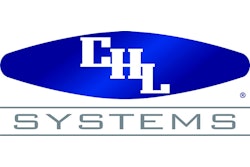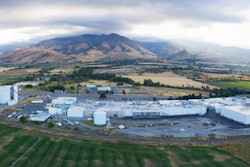
Just Born Quality Confections is perhaps best known for its PEEPS® Brand Marshmallow Chicks. But the Bethlehem, Pa.-based candy maker also cranks out plenty of product on starch mogul machines that make soft panned chewy candies. Two such products, HOT TAMALES® and MIKE AND IKE® Brand candies, have grown so popular that the two packaging lines running them in the Bethlehem plant could not keep up with demand. The firm addressed this challenge by adding one new packaging line and by seriously upgrading the two existing lines. Folding cartons receive candy from one of 18 cups on a volumetric filler running at about 450 cartons/min.
Folding cartons receive candy from one of 18 cups on a volumetric filler running at about 450 cartons/min.
The common denominator in all three lines is a Model VLX1-5 high-performance cartoning machine from PMI Kyoto Packaging Systems. A vertical cartoner with a volumetric filler, the machine picks carton blanks from a magazine feed and erects and bottom glues them before advancing them to an 18-funnel volumetric filler. Top flaps get glued shut and then finished cartons are discharged to inspection and secondary packaging. Oh, and it does this at 450 cartons/min. By comparison, the fastest throughput the firm had on either of its previous lines was more like 325/min.
According to Just Born manufacturing engineer Brent Edsoren, the three new cartoners bring two other key benefits in addition to increased throughput. One is versatility. The machines can be changed readily to fill cartons holding anywhere from 3 to 6 oz, though currently the lion’s share of production is in cartons holding 4.25 oz. But an even more important improvement that comes with the new machines is accuracy in product fill amount and line efficiency.
“What this generation of fillers has allowed us to do is get feedback from the downstream checkweigher so that we can automatically adjust the filler to zoom in on accuracy and provide a consistent package weight for our consumer,” says Edsoren. “With these new cartoners we think we're very comparable to what we get in accuracy out of the combination scales that we use for bagged product.”
The other significant change that took place at the Bethlehem plant revolves around the 12-count E-flute corrugated tray that serves as the secondary package. These open-top trays are of the shelf-ready variety, which means that as soon as in-store personnel remove the shrink film overwrap, the whole tray goes on the shelf and shoppers pick cartons from the corrugated trays. Feedback from both retailers and consumers indicated that the design of the tray’s front panel made it difficult to pull the first carton out without damage. So the two “wings” on the left and right front corners were eliminated, which also allowed the vibrant graphics on the primary package to do the merchandising at retail instead of the corrugated tray. This new configuration called for a new and purpose-built tray packing machine on both the new line and on one of the upgraded lines. More on this servo-driven Aagard tray packing system shortly. Immediately after being filled the cartons have their top flaps plowed and glued closed.
Immediately after being filled the cartons have their top flaps plowed and glued closed.
Starts at the mezzanine level
Packaging starts at the mezzanine level with product distribution to the filler. This is done by way of plastic totes carrying the finished candies, which are cartoned into single-flavor or multiple-flavor mixes. The totes are then automatically dumped in layers into a slow-moving conveyor and then into a mesh screening system from CHL Systems that ensures only properly sized candy drops through to a hopper leading down to the volumetric filler. If a mixed-flavor format is in production, the flavors have been evenly mixed into a steady flow by the time the product reaches the filler.
Candy pieces enter the PMI Kyoto system by way of a vibratory feeder and then across a broad path until they quickly find their way into the 18 volumetric cups that are sized according to how much product the cartons are supposed to get. Meanwhile, a short distance upstream is a servo-driven rotary feeder that uses vacuum cups to pick and erect flat carton blanks and place them into carton pocket carriers. After bottom flaps are glued closed by a Nordson adhesive application system, the carriers bring the cartons beneath the volumetric filler where the candy-filled cups open their bottom gates to fill the cartons. After carton tops are plowed closed and glued, the cartons are tipped flat on their sides and conveyed out of the cartoner. Before exiting the PMI Kyoto machine, cartons go through a laser coder from Markem-Imaje that puts date code information on each carton. Then a Mettler Toledo combination checkweigher/metal detector makes sure that any cartons out of acceptable weight range or have metal inside are rejected. Filled cartons run through this combination checkweigher and metal detector , which also communicates with the volumetric filler’s controller to improve filling accuracy.
Filled cartons run through this combination checkweigher and metal detector , which also communicates with the volumetric filler’s controller to improve filling accuracy.
The other important task performed by the Mettler Toledo checkweigher is that it constantly sends carton weights to the Rockwell controller on the PMI Kyoto machine. The controller monitors this data, and if an adjustment needs to be made, it sends a signal to a servo motor that automatically adjusts all 18 volumetric cups on that machine accordingly.
Exiting the Mettler Toledo system, cartons are single filed into the Aagard 507 tray packer. Considering that they’re moving at about 450/min, the tray packer has its work cut out for it. Not to worry, says Jesse Maland, Aagard lead applications engineer. “The machine is rated at 42 12-count trays per minute,” says Maland. Servo technology plays a big role, adds Maland.
“The infeed is basically one solid stream of cartons,” he continues. “The first thing we need to do is meter them out so that there is a gap between the trailing edge of one carton and the leading edge of the next. We accomplish this with a servo-driven overhead belt. As soon as this gapping is done, overhead flight bars move each carton forward. If any carton is improperly spaced, it’s detected and that carton is pushed out into a reject bin.”
Waterfall reorientation
Next is a waterfall section that reorients each carton from lying flat on its broad side to standing upright on its narrow edge side. “We needed a very fast way of orienting and collating the cartons into groups of 12,” says Maland. “We accomplish this with a pair of servo-driven tools. One holds the incoming stream of cartons back while the other pulls 12 cartons forward into a collating chamber. This chamber rotates from a 6 o’clock position up to a 12 o’clock position so that its 12 cartons can be pushed out into a load chamber. At the same time, an identical collating chamber arrives down at the 6 o’clock position to receive its 12 cartons. So one collating chamber is being relieved of its cartons as the other is being filled with cartons.” A versatile palletizer brings Line 1 to a close.
A versatile palletizer brings Line 1 to a close.
Each time a collated group of 12 cartons arrives at the load chamber, a two-axis Aagard-built robotic arm pulls that whole group forward and onto a corrugated tray that has been picked by vacuum and erected. A flighted mechanism running beneath the now filled tray pulls the tray at a right angle into a Nordson glue application and compression station. “We do all of the compression in one station, squaring up the back with overhead cylinders,” notes Maland. “And once the trays are through the compression station, two photo eyes look for any open flaps. If none are detected, that tray is pushed off at a right angle to the next machine in the line. But if an open flap is detected, that tray is dropped off into a reject conveyor.”
Before exiting the Aagard tray packer, the open top corrugated trays get SKU-specific information, barcode, and lot code printed on them by a Markem-Imaje Touch Dry Hot Melt ink-jet system. At this point, the trays proceed single file into an Arpac shrink wrapper and shrink tunnel supplied by nVenia . Wrapped trays are conveyed to an AmbaFlex spiral elevator so they can proceed over other packaging and manufacturing systems to another spiral elevator that takes them back down to floor level and the infeed conveyor leading to the Aagard 508 palletizer. This machine, notes Aagard’s Maland, is notable for how compact it is considering all the tasks it performs. “This had to be a very low-profile palletizer,” Maland explains, “because it had to fit underneath an HVAC system back in the corner of the warehouse. We purposely built it to fit that space.”
Versatile pick head
The palletizer’s pick head is versatile enough to use vacuum cups to pick a corrugated layer pad from a bin and place it on an empty pallet before then using mechanical grippers to pick that pallet and carry it into the station where layers of filled corrugated cartons are placed. The pick head then waits until a full layer of cartons has been formed and then it picks up that layer and places it on the pallet. One nice thing about the foam vacuum pick head from Joulin, a brand by Piab Group, says Maland, is that it can go from picking one layer format to another with no real changeover required. Pallets exiting the palletizer are taken to a stretch wrapping operation a short distance away that was already in place before Line 1 was installed. Shown here is the corrugated tray used formerly (top and middle) and the new format now in use (bottom).
Shown here is the corrugated tray used formerly (top and middle) and the new format now in use (bottom).
While all three of the cartoning lines running at the plant have the same new PMI Kyoto cartoner and Mettler Toledo combination metal detector/checkweigher, only Line 1 was brand new from stem to stern. Lines 2 and 7 experienced something more along the lines of an upgrade. On Line 2, that included the new Aagard 507 tray packer, but on Line 7, an existing tray packer was modified to accept the new corrugated tray design.
David Escott, manager of engineering and facilities group at Just Born, says that this was the firm’s first experience with PMI Kyoto cartoners. “What made us comfortable with them right from the beginning is that they obviously had so much experience handling products like ours at high rates of speed,” says Escott. “And when it came to startup, it exceeded our expectations. One thing we did to mitigate risk was to bring one cartoner in first and get people trained on it before bringing the other two in. It was a very systematic and successful approach.” PW

























